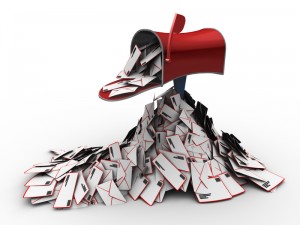
Is there a detox program for excessive holiday emails?
We don’t just overload on great food and drinks during the holiday season. I’m very glad I don’t gain a pound for every unwanted email I receive.
I recently read that 2011 Cyber Monday was the biggest and most successful retail year ever. So I’m scratching my head over a quote from the 2012 Email Marketing Benchmark Report:
Only 28% of messages contain relevant content.
But does this really surprise anyone? I get this. I just spent 25 minutes deleting unwanted emails from my iPhone. Emails that I had no interest in at all or the few that I did choose to open were well… misleading.
Here are two in particular that frustrated me.
10% off plus free shipping!
Well it was only on Christmas holiday decor. The items might have been beautiful but I don’t celebrate Christmas.
$50 off every $150 spent
Only on certain items, needless to say it was not the item I wanted.
I know that sending email is cheap, but you end up paying a higher price when you anger the customer. Best case, people opt out. Worst case, you head into spam. Most likely they just stop paying attention to your emails and delete them immediately.
At Scott Cooper Associates we constantly try to cut through the clutter, but it seems that most email marketers are just adding to it. After all the hard work we put into our email marketing objectives, it would be a shame to have a few bad email practices ruin it for the good guys. So I thought I would share some basic email tips that I’ve pick up from Email Marketing Reports.
1. Improve overall strategy and approach
Adopting best practices in all aspects of your email marketing produces sustainable, significant improvements in all success measures. A commitment to professional permission-based email marketing practice is your best long-term hope of raising open rates. To summarize: if you send useful, relevant, engaging emails to the right set of people at the right time, then open rates will rise.
2. Refine sign-up procedures and targeting
Reader interest in your emails depends on how targeted your audience are. The better you target, the more likely you are to plunk your email in front of someone who is interested in the contents (i.e. higher open rates). Targeting starts with where and how you gather email addresses.
You need to ensure that you set expectations correctly, so people sign up because they want what you send out. And you need to ensure they really do want those emails. Only add addresses to your list when the owners explicitly requested you do so. Respect that permission.
Targeting also comes into play when you send out your emails. It means matching content to reader. Which is where it helps to split up your list into smaller groups sharing particular characteristics, letting you fine tune your messages to their needs, i.e. segmentation.
3. Get people to add you to their address list
In your welcome message or at the top of each email you send out, you can invite people to add your “from” address to their personal address list. As well as helping you bypass spam filters set up by that individual, it often means their email client or web-based email service will now display images that were previously blocked in your emails. Which means the tracking image gets requested and opens show up where before they were missed.
4. Subject lines and other headers
The subject line is probably the single most important in-email element that drives open rates. Bad subject lines, poor open rates. Good subject lines, good open rates. When you’re exploring the potential of subject lines, don’t forget the other elements that appear in the headers of an email and get displayed in a reader’s inbox. The “from” line in particular needs your attention, as people are most likely to open email from senders they recognize.
5. Timing
Open rates will vary for the same email sent on different days or at different times of the day. There are a lot of folks who will claim various days and times are best. These recommendations are based on averages and not on the specific characteristics of your list and situation. Use your intuition to gauge when people are most likely to have the time and interest to view your email and go from there. Then test alternatives and see how they work out.
6. Frequency
Send too much email and people lose interest. Send too little email… and people lose interest.
So what’s the right amount of email to send out? It depends on your situation. And don’t forget that responses to your marketing emails are affected by all the email your company or business sends out to recipients (transactional emails, personal emails, account updates, welcome messages etc.)
As a rule of thumb, it’s hard to sustain open rates when you send more than two marketing emails a week to a recipient. Ditto at once a month or less. Not impossible — just hard — as you’re fighting email fatigue and forgetfulness on top of all the usual problems.
Personally, I love communicating via email. And email marketing has become a large part of our business. I’ll be sure to learn from the email overload I experienced this holiday season. After all, I’m one of the nice guys and I don’t want to piss people off.
Happy New Year!